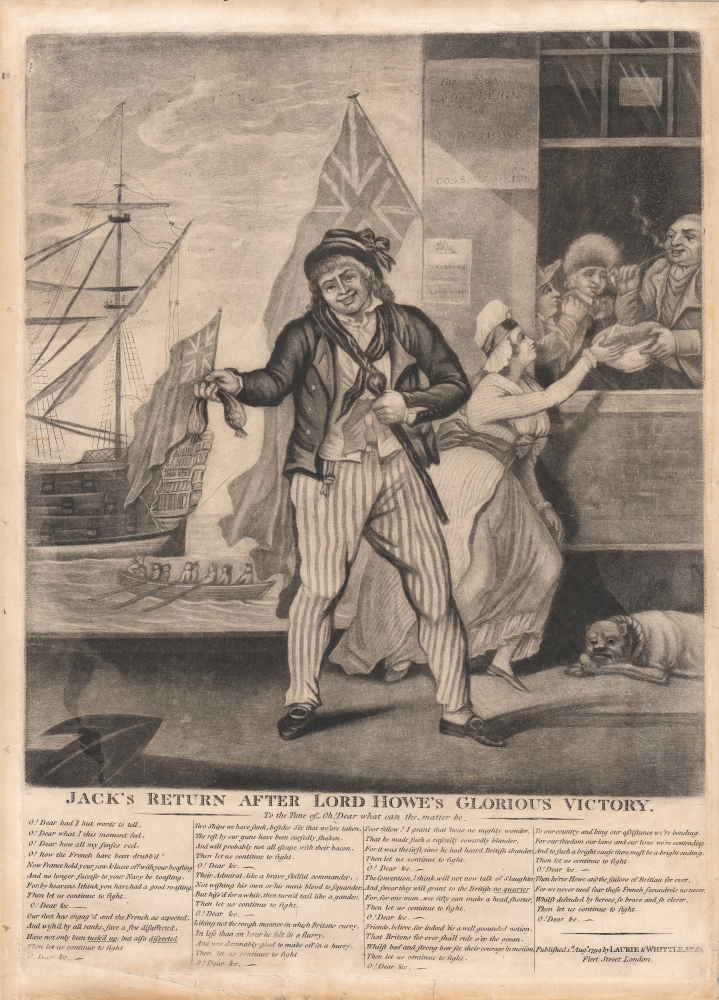This item has been sold, but you can get on the Waitlist to be notified if another example becomes available, or purchase a digital scan.
1794 Laurie and Whittle Broadsheet, The Glorious First of June
JacksReturn-lauriewhittle-1794
Title
1794 (dated) 14.5 x 10.5 in (36.83 x 26.67 cm)
Description
A Closer Look
'Jack' or 'Jack Tar' was an 18th century term referring to British sailors. This broadsheet portrays a generic sailor returning from the British 'victory' known as the Glorious First of June, under the command of Admiral Richard Howe. He holds a purse in one hand (pay for his service) and papers and a stick in the other. Behind, a group of men sit celebrating and smoking in a pub pass a bowl of punch out the window to a woman on the street. Patriotic posters and a British flag adorn the side of the pub while a ship in the background is depositing more sailors on the shore via rowboat. The text at bottom is a reworking of the song 'Oh Dear! What Can the Matter Be?' with patriotic lyrics praising Howe and mocking the French.There was a surge in prints relating to the Royal Navy around this time, as the sea was the primary arena for fighting between Britain and Revolutionary France during the War of the First Coalition. While sailors were esteemed for their role in defending the British Isles, there was no mystery about the difficulties of life on the sea, and men could be press-ganged into service if the ranks needed to be filled.
The Glorious First of June
The Glorious First of June (1794), fought in the North Atlantic far off the coast of Ushant, was the first and ultimately the largest naval engagement between Britain and France during the French Revolutionary Wars. It was driven by British efforts to cut off grain convoys from the United States to France. Howe adopted the unusual tactic of raking enemy ships, which might have proved decisive, but his orders were not understood or followed by all the ship captains. The French lost seven ships and the British none, while the American grain convey did make it through. Both sides claimed victory and returned to port to a hero's welcome. Critically, however, the British damaged the French fleet badly enough that they could blockade France for the rest of the war.Publication History and Census
This print was published by Laurie and Whittle on August 1, 1794. It is only known to be held by Yale University, Brown University, and the British Museum and has no known history on the market.Cartographer
Laurie and Whittle (fl. 1794 - 1858) were London, England, based map and atlas publishers active in the late 18th and early 19th century. Generally considered to be the successors to the Robert Sayer firm, Laurie and Whittle was founded by Robert Laurie (c. 1755 - 1836) and James Whittle (1757-1818). Robert Laurie was a skilled mezzotint engraver and is known to have worked with Robert Sayer on numerous projects. James Whittle was a well-known London socialite and print seller whose Fleet Street shop was a popular haunt for intellectual luminaries. The partnership began taking over the general management of Sayer's firm around 1787; however, they did not alter the Sayer imprint until after Sayer's death in 1794. Apparently Laurie did most of the work in managing the firm and hence his name appeared first in the "Laurie and Whittle" imprint. Together Laurie and Whittle published numerous maps and atlases, often bringing in other important cartographers of the day, including Kitchin, Faden, Jefferys and others to update and modify their existing Sayer plates. Robert Laurie retired in 1812, leaving the day to day management of the firm to his son, Richard Holmes Laurie (1777 - 1858). Under R. H. Laurie and James Whittle, the firm renamed itself "Whittle and Laurie". Whittle himself died six years later in 1818, and thereafter the firm continued under the imprint of "R. H. Laurie". After R. H. Laurie's death the publishing house and its printing stock came under control of Alexander George Findlay, who had long been associated with Laurie and Whittle. Since, Laurie and Whittle has passed through numerous permeations, with part of the firm still extant as an English publisher of maritime or nautical charts, 'Imray, Laurie, Norie and Wilson Ltd.' The firm remains the oldest surviving chart publisher in Europe. More by this mapmaker...

